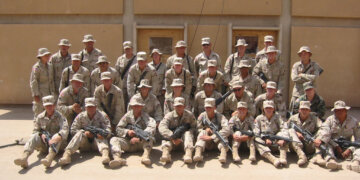Women account for more than 20% of service members in the National Guard and reserves – a number that has been steadily growing since 2017, according to the 2021 Demographics Profile of the Military Community.
Those armed forces members are among the history makers who have enlisted since the Women’s Armed Services Integration Act was signed in 1948, formally allowing women to serve in the military outside of war periods.
The following reserve component female leaders only represent a small piece of each branch’s history, but the steps these women took to affect change have influenced future generations of women.
Army Reserve

In 2002, Sgt. Maj. Michelle Jones became the first woman appointed command sergeant major of the U.S. Army Reserve. At one point, she was the highest-ranking Black female enlisted person in any branch and the highest-ranking enlisted Black person in the U.S. military.
While she was the command sergeant major, she traveled the world . These included helping extend privileges for the reserve component, including gaining commissary access and extending TRICARE to all military members and retirees. She served in the Army for 25 years, after which she served as director of external veterans/military affairs and community outreach under the Obama Administration. She has been honored with many awards and accolades, the highest military award being the Legion of Merit. She was also recognized with the Spirit of Democracy Lifetime Achievement Award from the National Coalition on Black Civic Participation.
Air Force Reserve
Col. Kathy Cosand knew she wanted to be a pilot at the age of 7 when she witnessed John Glenn launch into space. At the time, the door wasn’t open for women to be pilots in the military. But in 1976, the Air Force allowed 20 women to be pilots.
RELATED: Bea Arthur’s Marine Corps service ‘evidence of badassery’
Cosand was selected to fill the only spot open for a reservist. In 1977, she and nine other women became the first women to graduate from the Air Force Undergraduate Training Program. Another two of her accomplishments were being the first female aviator to qualify in the C-141 and the first female to earn the Air Medal after a mission to Zaire in 1978.
Navy Reserve
Rear Adm. Grace Murray Hopper joined the Navy Reserve in 1943 and commissioned in 1944. She was also rejected because of her small size. Her first assignment was the Bureau of Ordnance Computation Project at Harvard. She was a computer programmer and learned to program on the first large-scale digital computer Mark I.

She was instrumental in creating the programming code language, Common Business Oriented Language (COBOL). COBOL is one of the earliest standardized computer languages and is still in use today among computer programmers. She served in the reserves until 1966, but was recalled to active duty in 1967 and continued to serve on active duty and in the reserves until 1986. She was awarded the Defense Distinguished Service Medal for her more than 42 years of service.
Marine Corps Reserve
Col. Ruth Cheney Streeter was the first woman to lead the Marine Corps Womens Reserve (MCWR), but she actually wanted to fly. She saw the potential for war and gained her pilot’s license. In 1941, she joined the Civil Air Patrol and even though her plane was used to fly missions aimed at keeping the enemy subs down she was relegated to the position of adjutant. She also applied to be part of the Women Airfare Service Pilots even though she was 12 years past the age limit. She was rejected five times.
Then in January 1943, she inquired with the Navy about service in the WAVES as a pilot. She was told she could be a ground instructor and declined. A month later she was commissioned as a major and selected as the director for MCWR. She, with the help of her counterpart Col. Brewster Rhodes, helped form the foundation for women serving in the Marine Corps.
Read comments





























